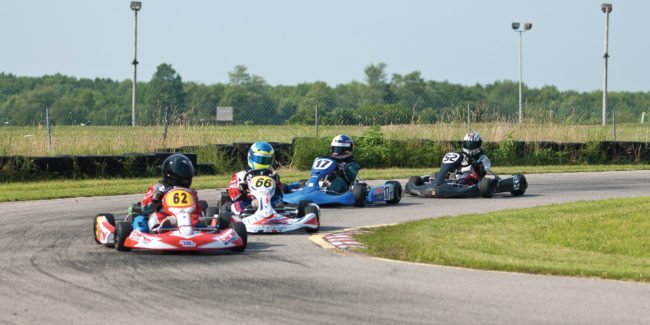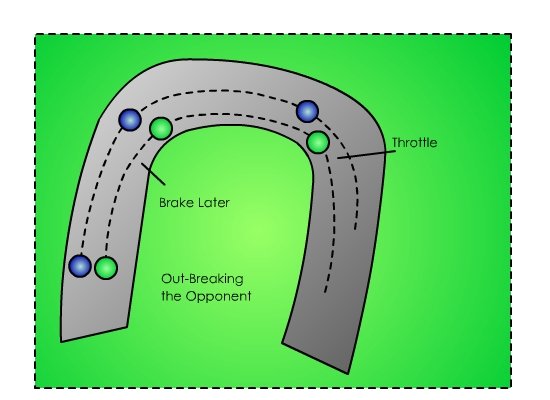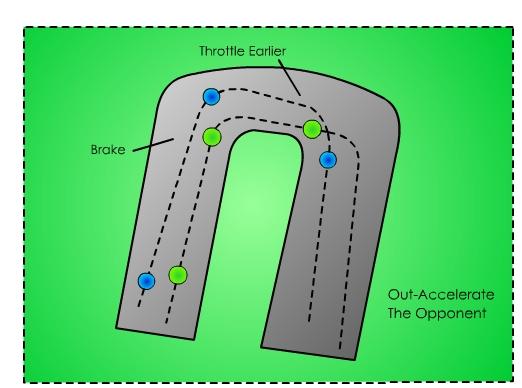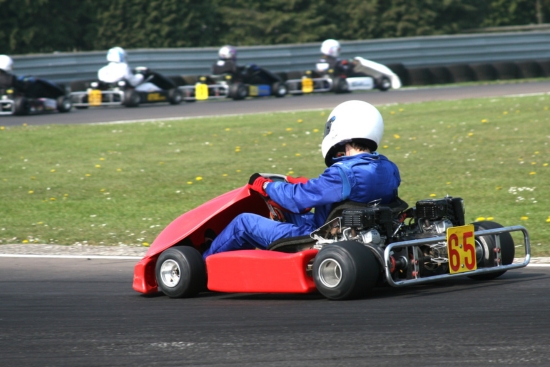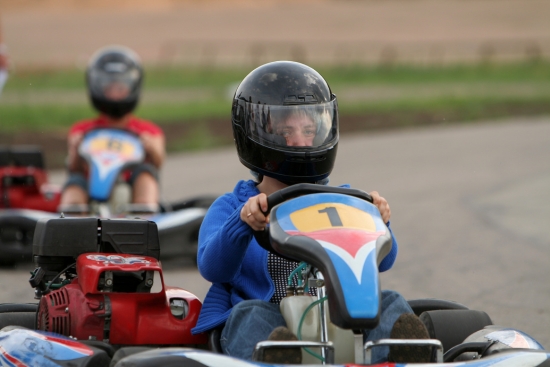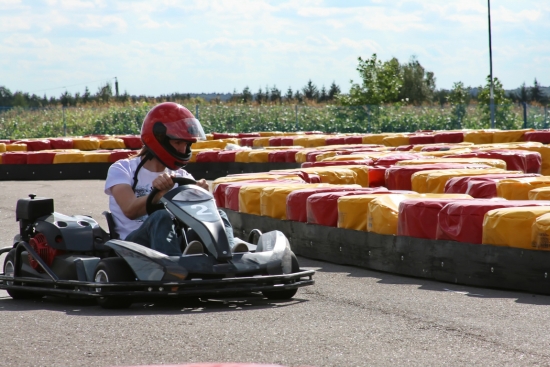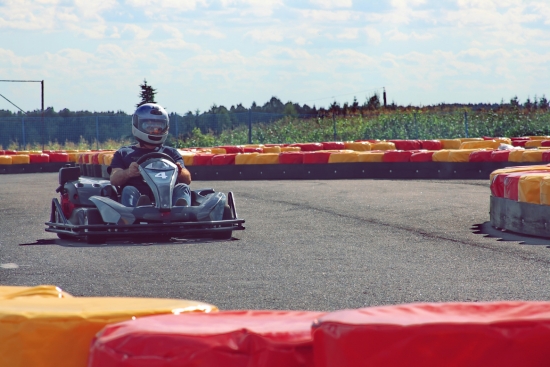Overtaking or go kart passing is a very important part of go kart racing. There will be countless numbers of opportunities to pass and be passed every time you head out to the track. Whether it’s during practice or during the final points race of the event or the season, passing needs to be smooth and efficient. Even if you are not a serious kart racer and you are using family friendly indoor track…we will cover the most important moves you need for success.
In this article, we will cover the two most important techniques used to overtake your opponents when cornering; out-braking in and out-accelerating out. Of course, there are other times to pass, but these will be your best opportunities for a clean overtake.
Understand the Track
During a practice or qualifying session on the track, it is a good idea to consciously look for places on the track that you might be able to pass on. Consider the fastest racing line you would drive in a situation you might pass and practice it a few times. This way, when you start the race you already have a plan of how you’re going to get up to the front in the least time possible.
Wide parts of the lap around the track are the most ideal and the safest, but tight turns can offer the perfect element of surprise although you need to be able to pass both clean and safe. The idea is to find spots of vulnerabilities where other drivers may go wide or take turns to tight.
How to Pass in a Go Kart Race
The most likely way you are going to be able to pass someone on the track is if you are able to choose to out-brake or out-accelerate you opponent in a turn.
Out Braking Your Opponent Into a Corner
The title is pretty much self-explanatory. You have to be able to out-brake your opponent into the corner so that you have the advantage on the inside. You will have a tighter line and will be able to pull away with your speed coming out of the corner. The move starts with getting parallel to your opponent and essentially you are preventing them from turning in.
In the diagram below, the green dot represents the proper passing move.
Here is the step-by-step approach to a proper out-brake pass:
- Get parallel to your opponent
- Brake slightly later than them on the turn-in
- Ease off the throttle and maintain the inside line
- Visually check where your opponent’s kart is in relation to yours
- Accelerate on the turn exit and move onto your opponent’s line (if its safe)
Pro Tip: Avoid “Diving” into the corner to avoid an accident. As a general rule, make sure that the person you plan on overtaking has seen you and knows not to turn into you to overtake them. If you are not at least level with the other go-karter before they start turning in, back off. Otherwise, you may cause an accident and be disqualified.
If you are trailing an opponent and not parallel, you can also look for an opportunity when the car ahead of you starts to drift wide into a corner and they leave a gap to the inside. You can accelerate into and out-brake them (risky move though, cause they still need to see you). If it’s not meant to be back off and wait for another corner.
Out braking is a good technique, but it is often the slowest way through a corner as it utilizes the early apex.
Out-Accelerating Out of the Corner
Your goal when using this method of overtaking is to use a wider line going into the corner so that you may start to accelerate before engaging your opponent. The goal is to be heading straight forward on the first set of throttle as your opponent is just coming out of the corner.
In the diagram below, the blue dot represents the proper passing move.
Here is the step-by-step approach to a proper out-brake pass:
- Take a wide approach on the corner (use threshold braking)
- At the end of the braking zone begin your acceleration
- Aim for the late Apex on the corner exit
- Look to be full throttle and straighten your wheels as fast as possible
Pro Tip: This is best executed when your opponents have a tendency to turn in early. The key to pulling it off correctly is to time your throttle compression in a straight line, while your opponent is still cutting their wheel for their turn exit and can’t accelerate at the same rate you can because of the slip angle of their tires.
Out-accelerating using the late apex is the fastest way to drive through the corner and is a pro-passing move.
Safety Considerations in Go Kart Passing
Understanding the Risks of Overtaking
In kart racing, safety is paramount, especially when it involves overtaking. The thrill of the race can sometimes overshadow the risks associated with aggressive maneuvers. When a driver attempts to overtake, they must be acutely aware of their surroundings and the speed of both their own kart and that of their competitors. Achieving the fastest lap time is often a goal, but it should not compromise safety.
Overtaking typically occurs on parts of the track where karts can safely pass each other. However, the risk increases if a driver misjudges the distance or the speed of the other karts. Collisions can happen, leading to potential injuries or damage to the karts. Therefore, understanding and assessing the risk before attempting to overtake is crucial.
Maintaining Control During Aggressive Maneuvers
Maintaining control of the kart during aggressive maneuvers is essential for safe karting. This involves having a good grip on the steering and understanding how the kart reacts to quick turns and sudden accelerations. Drivers must be skilled in controlling their kart’s torque and rpm to prevent spinning out or losing control.
Training and practice play a significant role in helping drivers develop these skills. Karting schools and tracks often provide sessions where drivers can learn and practice in a controlled environment. This is especially important for younger drivers or those new to the sport, as they need time to build their confidence and skill level.
Respecting Racing Etiquette and Rules
Respecting racing etiquette and rules is crucial in kart racing. This includes understanding the right of way, signaling intentions to other drivers, and adhering to track rules. Racing events often have specific guidelines that all participants are required to follow. These rules are in place to ensure everyone’s safety and to keep the event fair and enjoyable for all.
For instance, a driver should never force another kart off the track or engage in behaviors that could be deemed dangerous. It’s also important for adults and drivers to respect the legal guardian or parent if they are racing with minors. Additionally, wearing the required safety gear, such as helmets and suits, is mandatory to minimize the risk of injury.
In conclusion, while overtaking is a thrilling part of kart racing, it must be done with a strong emphasis on safety. Understanding the risks, maintaining control of the kart, and respecting the rules and etiquette of the sport are all essential aspects of safe and responsible karting.
Training and Practice for Effective Passing
Kart racing demands not only skill but also a strategic mind. To excel in this sport, one must engage in regular training and practice. This section delves into the essential drills and exercises that enhance passing skills, the significance of consistent practice, and the benefits of learning from racing simulations.
Drills and Exercises for Improving Passing Skills
Effective passing in karting is a blend of timing, precision, and understanding your kart’s capabilities. To improve these skills, specific drills can be immensely helpful. One such drill involves setting up cones on a track to simulate various racing scenarios. This exercise helps drivers practice overtaking maneuvers in a controlled environment, enhancing their ability to judge speed and distance accurately.
Another useful exercise is the ‘follow the leader’ drill, where a group of karters follow a lead kart, mimicking its movements. This drill teaches drivers how to anticipate and react to the actions of the kart in front, a crucial skill for competing effectively.
Importance of Consistent Practice
Consistency is key in mastering the art of kart racing. Regular practice sessions help in building muscle memory and refining the techniques required for successful overtaking. It’s not just about the number of hours spent on the track but also about the quality of practice. Setting small, achievable goals for each session can lead to significant improvements over time.
For younger enthusiasts, karting can be a fun way to celebrate a birthday or a party with friends, while also honing their racing skills. Groups of all ages can benefit from the challenge and excitement of kart racing.
Learning from Racing Simulations
In today’s digital world, racing simulations offer a valuable tool for learning and improving kart racing skills. These simulations provide a risk-free environment to experiment with different racing techniques and understand the dynamics of karting. They are particularly useful in familiarizing oneself with various tracks and racing conditions.
Simulations can also be a part of a corporate event or team-building exercise, where participants can engage in friendly competition while learning the basics of kart racing. Moreover, simulations offer a safe and accessible way for beginners to get a feel of the sport before they set foot on an actual track.
In conclusion, effective passing in kart racing is a skill that can be developed with the right mix of practical drills, consistent practice, and the use of modern racing simulations. Whether it’s for personal enjoyment, a corporate event, or competitive racing, these methods provide a solid foundation for anyone looking to excel in this thrilling sport.
Go Kart Overtaking – Wrap up
Understanding these two techniques will carry you a long way into winning more races and getting your season points. There is a certain art to it and it requires timing, patience, and practice. The diagrams above are for one turn type tracks, but can generally be applied to most corner angles.
For more information and other pro go karting and racing tips you can check out the top 10 cornering techniques which will also help you to pass like a pro kart racer.

